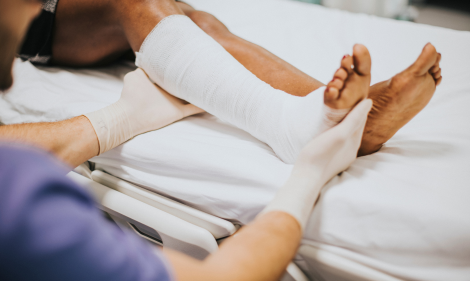Standing Strong Again: Leg Injuries After Car Accidents
Car accidents can cause devastating injuries to the legs, leaving victims unable to walk, work, or live normally. From simple sprains to complex fractures, these injuries not only bring physical pain but also emotional and financial challenges.
At Specialty Care Clinics, we provide expert care for leg injuries after auto accidents, helping patients restore mobility, strength, and independence.

Why Leg Injuries Are Common in Car Accidents
- Front-seat collisions: The legs often hit the dashboard or steering column.
- Side-impact crashes: Knees and thighs are crushed against car doors.
- Pedestrian accidents: Direct trauma causes multiple fractures.
- Seatbelt/airbag force: Sudden restraint can strain or twist leg muscles.
The legs bear the body’s weight, so even minor damage can lead to long-term mobility issues if left untreated.
Types of Leg Injuries After Car Accidents
1. Fractures (Broken Bones)
- Femur (thigh bone) fractures – extremely painful and require surgery.
- Tibia and fibula (shin bones) fractures – often from direct impact.
- Patella (kneecap) fractures – usually from hitting the dashboard.
2. Soft Tissue Injuries
- Ligament tears (ACL, MCL) – common in knee twisting injuries.
- Muscle strains & sprains – overstretching during impact.
- Tendon injuries – Achilles tendon ruptures can occur in severe crashes.
3. Joint Injuries
- Knee dislocations (rare but severe).
- Hip dislocations from side impacts.
- Ankle sprains and fractures.
4. Crush Injuries
Severe accidents can trap legs under debris, leading to tissue death or even amputation in extreme cases.
Symptoms That Shouldn’t Be Ignored
- Severe pain or swelling in the leg
- Inability to bear weight or walk
- Visible deformity or bone protrusion
- Bruising, numbness, or tingling
- Limited range of motion in the hip, knee, or ankle
Even mild pain should not be ignored, as small fractures or ligament tears can worsen over time.
Diagnosis of Leg Injuries
At Specialty Care Clinics, we use advanced diagnostic tools to identify the extent of damage:
- X-rays – to detect fractures.
- MRI scans – to evaluate ligament and tendon injuries.
- CT scans – for complex fractures and joint damage.
- Physical examinations – to assess strength, flexibility, and stability.
Treatment Options for Leg Injuries
1. Non-Surgical Treatments
- Rest, ice, compression, and elevation (RICE method).
- Bracing or casting to immobilize fractures.
- Pain medications and anti-inflammatory drugs.
- Physical therapy for strength and mobility.
2. Surgical Treatments
- Metal rods, plates, or screws to stabilize broken bones.
- Arthroscopic surgery for ligament repairs.
- Joint replacement (in severe cases of hip or knee damage).
- Emergency surgery for crush injuries to prevent complications.
Long-Term Complications of Untreated Leg Injuries
- Chronic pain and stiffness
- Arthritis in damaged joints
- Permanent loss of mobility
- Muscle weakness and imbalance
- Risk of blood clots (deep vein thrombosis)
Without timely care, leg injuries can lead to lifelong disability.
Recovery and Rehabilitation After Leg Injuries
At Specialty Care Clinics, rehabilitation is tailored to each patient:
- Physical therapy: Improves strength, balance, and flexibility.
- Occupational therapy: Helps patients return to daily activities.
- Pain management programs: To reduce chronic discomfort.
- Adaptive aids: Crutches, braces, or wheelchairs if needed.
Recovery times vary:
- Minor sprains may heal in 2–6 weeks.
- Fractures may take 3–6 months.
- Severe injuries requiring surgery may need a year or more for full recovery.
Prevention Tips: Protecting Your Legs on the Road
- Always wear your seatbelt properly.
- Keep knees slightly bent while driving (not locked).
- Adjust the seat to avoid direct impact with the dashboard.
- Wear supportive footwear while driving.
- Seek immediate medical evaluation after any accident.
Conclusion
Leg injuries after car accidents can change your life in an instant, but with timely medical care and rehabilitation, recovery is possible. At Specialty Care Clinics, we provide comprehensive treatment plans—from emergency care to rehabilitation—ensuring patients regain mobility and independence.
Need Auto Accident Injury Treatment in Texas?
Visit: Specialty Care Clinics – Auto Injury Treatment
Call: (972) 865-4454
FAQs
Q1: How long does it take to walk again after a leg fracture?
It depends on the severity. Simple fractures may heal in 8–12 weeks, while complex ones may take several months.
Q2: Can ligament tears heal without surgery?
Some mild tears can heal with rest and therapy, but complete tears (like ACL) often require surgery.
Q3: Is it normal to have swelling in the leg weeks after an accident?
Mild swelling can persist, but excessive or worsening swelling may indicate complications like a blood clot.
Q4: What is the most serious leg injury from car accidents?
Femur fractures and crush injuries are among the most severe, often requiring surgery and long-term rehabilitation.
Q5: Where can I get expert care for leg injuries after a car accident?
At Specialty Care Clinics in Texas, where our specialists provide advanced diagnostics, surgical care, and personalized rehabilitation plans.
